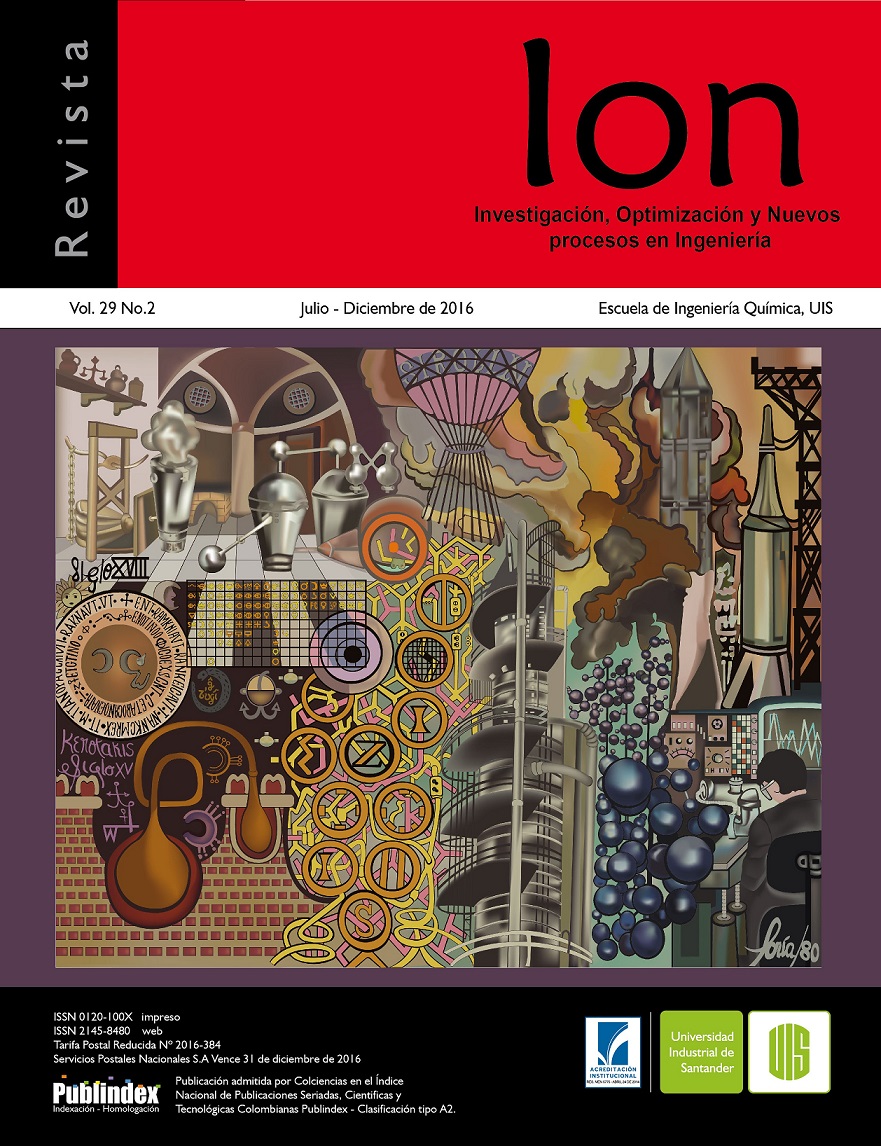Predicción del número de bromo de naftas colombianas usando espectroscopía infrarrojo cercano y métodos quimiométricos
Publicado 2016-12-15
Palabras clave
- FT-NIR,
- Nafta,
- Número de Bromo,
- PCA,
- PLS
- MPR. ...Más
Cómo citar
Resumen
En este trabajo se emplearon treinta y ocho muestras de nafta para desarrollar un método quimiométrico
para predecir el número de bromo. Las muestras se caracterizaron por espectroscopía infrarrojo cercano con transformada de Fourier (FT-NIR) y sus espectros fueron correlacionados por similitud utilizando análisis de componentes principales (PCA). Los modelos de calibración del número de bromo (BN) se llevaron a cabo por regresión de mínimos cuadrados parciales (PLS) y regresión polinomial múltiple (MPR). El PCA clasificó las muestras en livianas y pesadas y permitió determinar las variables espectrales más importantes. Estas variables están localizadas en las regiones entre 4000-4800 y 5200- 6300cm-1. Los resultados obtenidos empleando esta metodología fueron muy cercanos a los obtenidos por los métodos standard. Por tanto, esta metodología puede ser una alternativa para el análisis del BN, por su bajo costo y menor tiempo de análisis.
Descargas
Referencias
[2] Falla FS, Larini C, Le Roux GAC, Quina FH, Moro LFL, Nascimento CAO. Characterization of crude oil by NIR. J Petrol Sci Eng. 2006;51(1– 2):127–37.
[3] Borges B, Acevedo S. Caracterización estructural de distintas fracciones aisladas del crudo extrapesado de Carabobo. Rev. Latinam. Metal. Mater. 2007;27(2):83–94.
[4] Mullins OC. The Modified Yen Model. Energy Fuels. 2010;24(6):2179–207.
[5] Bezerra De Lira L, Vera F, Fernandes C, Silveira AP, Stragevitchb L, Pimentel MF. Prediction of properties of diesel/biodiesel blends by infrared spectroscopy and multivariate calibration. Fuel. 2010;89:405–9.
[6] Orrego-Ruiz JA, Guzmán A, Molina D, MejíaOspino E. Mid-infrared Attenuated Total Reflectance (MIR-ATR) predictive models for asphaltene contents in vacuum residua: asphaltene structure–functionality correlations based on Partial Least-Squares Regression (PLS-R). Energy Fuels. 2011;25:3678–86.
[7] Orrego-Ruiz JA, Mejía-Ospino E, Carbognani L, López-Linares F, Pereira-Almao P. Quality Prediction from Hydroprocessing through Infrared Spectroscopy (IR) Energy Fuels. 2012;26:586–93.
[8] Meléndez LV, Lache A, Orrego-Ruiz JA, Pachón Z, and Mejía-Ospino E. Prediction of the SARA analysis of Colombian crude oils using ATR– FTIR spectroscopy and chemometric methods. J. Pet. Sci. Eng. 2012;90-91:56–60.
[9] Chung H, Ku M, Lee JS. Comparison of nearinfrared, infrared, and Raman spectroscopy for the analysis of heavy petroleum products Appl. Spectrosc. 2000;54:239–45.
[10]ASTM D1159–07, Standard Test Method for Bromine Numbers of Petroleum Distillates and Commercial Aliphatic Olefins by Electrometric Titration, ASTM International, West Conshohocken, PA, 2012.
[11] Carbognani L, Lopez-Linares F, Trujillo M, Wu Q, Carbognani J, Pereira-Almao P. On the determination of olefins in heavy oil, bitumen and their upgraded products. Div. Energy Fuels. ACS Energy Fuels Preprints. 2012;57:685-8.
[12]Fusheng O, Xu PXuhong, Z, Xuan L, Huixin W. Effect of Operating Conditions on Olefin Distribution in FCC Gasoline as Part of an Olefin Reduction Process China Pet. Process. Petrochem. Process. 2010;12:34-42
[13]Wold S. Chemometrics; what do we mean with it, and what do we want from it? Chemom. Intell. Lab. Syst. 1995;30:109–15.
[14]N. Aske, H. Kallevik, J. Sjöblom. Determination of saturate, aromatic, resin and asphaltenic (SARA) components in crude oils using infrared and near-infrared spectroscopy. Energy Fuels. 2001;15:1304–12.
[15]Satya S, Roehner RM, Deo MD, Hanson FV. Estimation of properties of crude oil residual fractions using chemometrics. Energy. Fuels. 2007;21:998–1005.
[16]Syunyaev RZ, Balabin RM. Frequency dependence of oil conductivity at high pressure. J. Disp. Sci. Technol. 2007;28:419-27.
[17]Syunyaev RZ, Balabin RM. Polarization of Fluorescence of Asphaltene Containing Systems. J. Disp. Sci. Technol. 2008;29:1505- 14.
[18] Kaplan IG. Intermolecular Interactions: Physical Picture, Computational Methods and Model Potentials. México: John Wiley & Sons; 2006.
[19] Wold S, Sjöström M, Eriksson L. PLS-regression, a basic tool of Chemometrics. Chemom. Intell. Lab. Syst. 2001;58:109-30.
[20] Cheung V. A comparative study of the characterization of colour cameras by means of neural networks and polynomial transforms. Color. Technol. 2004;120:19-25

